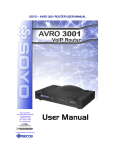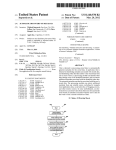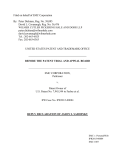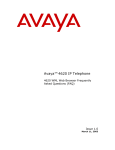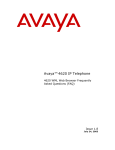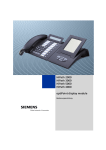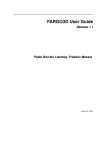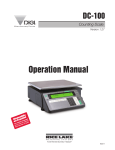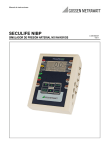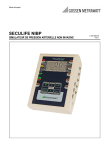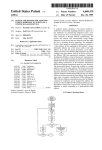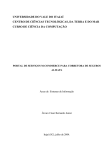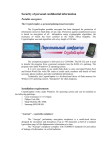Download Playing of audio via voice calls initiated from visual navigation
Transcript
US007035620B2
(12) United States Patent
(10) Patent N0.:
(45) Date of Patent:
Ben-Efraim et al.
(54)
PLAYING OF AUDIO VIA VOICE CALLS
INITIATED FROM VISUAL NAVIGATION
Forum LTD, 2000, pp. 1-54.
“WAPman”
http://WWW.edgematriX.com/products/
mainiWapman.htm., Oct. 19, 2000, pp. 1-2.
(Continued)
Primary ExamineriLee Nguyen
(73) Assignee: At Road, Inc., Fremont, CA (US)
Notice:
Apr. 25, 2006
Jul. 7, 2000, Copyright Wireless Application Protocol
(75) Inventors: Amir Ben-Efraim, Redwood City, CA
(US); Marco Del Pellegrino, San
Mateo, CA (US)
(*)
US 7,035,620 B2
(74) Attorney, Agent, or FirmiMary Jo Bertani; Koestner
Bertani LLP
Subject to any disclaimer, the term of this
patent is extended or adjusted under 35
(57)
U.S.C. 154(b) by 698 days.
ABSTRACT
Descriptions of audio contents available for playback via
(21) Appl. No.: 09/737,435
voice calls are displayed visually on a screen of a telephone
handset (such as a cellular phone supporting Internet access,
(22) Filed:
Dec. 11, 2000
(65)
(52)
(58)
On selection of an audio content, the handset places a voice
call to a computer that plays the audio content to the user
Prior Publication Data
US 2004/0204116 A1
(51)
or a personal digital assistant supporting voice telephony).
(during the voice call). A data connection is used to retrieve
description(s) for visual display, but this data connection is
Oct. 14, 2004
not used for retrieval of a ?le containing the audio content.
Int. Cl.
H04M 11/00
Instead, a voice call is placed in the normal telephony
manner, and the audio content is played by the computer that
receives the voice call. The just-described method and
(2006.01)
US. Cl. ................. .. 455/412.1; 455/3.03; 455/566
Field of Classi?cation Search ........... .. 455/412.1,
system eliminates a prior art need for the user to navigate
through a set of voice prompts to identify an audio content
to be played, eg as required by an interactive voice
response system. Instead, the user merely uses a display of
455/412.2, 418, 566, 564, 3.03; 379/8817,
379/8825; 370/463; 709/217e219
See application ?le for complete search history.
(56)
the handset and the related input mechanism (such as touch
References Cited
screen or keypad) to navigate eg through a list of hits from
a search engine, or through a number of categories and
subcategories to identify an audio content. The combination
of a conventional visual interface for navigation and a
conventional audio interface for serving audio contents
provides the bene?ts of both: the ease of navigation pro
U.S. PATENT DOCUMENTS
6,654,367 Bl*
2001/0043684 Al*
ll/2003
ll/200l
Kaufman .................. .. 370/356
Guedalia et a1. ....... .. 379/8817
OTHER PUBLICATIONS
vided by Web pages, and the quality of audio playback
“Questions about WTAI” http://dev.forum.nokia.com/
Wapboard/messages/15746.html, Aug. 8, 2000, pp. 1-2.
“Wireless Application ProtocoliWireless Telphony Appli
cation Interface Speci?cation” WAP-170-WTAI, Version
provided by the telephone handset.
38 Claims, 9 Drawing Sheets
use a data connection to
receive descriptions of
audio content and
corresponding telephone
numbers
“in
l
display the received
descriptions to user (and
optionally the phone
an
numbers)
receive from the user
a selection of one of the
descriptions (or optionally
a selected phone
number)
’
1
place a voice call to
play selected audio ,/l'-|Li
some ht
wait for voice call
to be completed
no’
i|5
US 7,035,620 B2
Page 2
OTHER PUBLICATIONS
Rytkonen, K, Mobile commerce and WMLihtIpJ/WW
W. gca/org/papers/Xmleurope2000/papers/ s 1 3-01 .html, Oct.
19, 2000, p. 1-15.
“Wireless Application ProtocoliWireless Telephony Ap
plication Interface Speci?cation” WAP-169WTA, Version
Jul. 7, 2000 Copyright Wireless Application Protocol Forum
LTD, 2000, pp. 1-49.
A WAP Tutorialihttp://WWW.Wapdesign.org.uk/tutorial.
html, Oct. 19, 2000, pp. 1-5.
“GB
Direct”ihttp : //gddirect. co .uk/ouropinions/
Wapimpressions.htm, Oct. 19, 2000, pp. 1-10.
Heikkinin, T, “Wireless Application PI‘OIOCOl”ihtIpZ//WWW.
tml.hut.?/Opinnot/Tik-111.550/1999/Esitelmat/Wap/Wap/
WAP.html, Aug. 4, 1999, pp. 1-10.
“WML
Tutorial”ihttp://WWW.Wak-uk.com/Developers/
Tutoria.html, Oct. 19, 2000, pp. 1-8.
Farley, T, “Cellular Telephone Basics: Amps &
Beyond”ihttp://WWW.privateline.com/Cellbascis/
Cellbasics.html, Oct. 19, 2000, p. 1-61.
“WAP Forum”ihttp ://WWW1 .Wapforum. org/tech/terms.
asp?doc:WAP-100-WAPArch-19980430-a.pdf, Oct. 19,
2000, pp. 1-3.
Wireless Application Protocol White Paper, Wap Forum,
“Tag/Screen image correspondence tables for I-made
compatible HTML 1.0 & 2.0”http://WWW.nttdocomo.com/i/
tag/index.html, Oct. 31, 2000, 3 pages.
“An
Introduction
To
VoiceXML”
http://WWW.
Wirelessdevnet.com/training/voicexml/voiceXmlovervieW.
html, Oct. 31, 2000, 3 pages.
“Dialogic Vocie Products D/21H D/41/H”, Unknown date
believed to be prior to Dec. 11, 2000, 8 pages.
Dreier, Troy, “InfoGear iPhone”, PC Magazine, http://WWW.
Zdnet.com/?lters/printerfriendly/O,6061,2307571-50,00.
html, Aug. 2, 1999, 2 pages.
“BigPlanet-iphone”,
http://WWW.bigplanet/com/products/
iphone/index.html, Nov. 1, 2000, 1 page.
“BigPlanet-Using Your Phone”, http://WWW.bigplanet.com/
products/iphone/using.html, Nov. 1, 2000, 1 page.
“BigPlanet-iphone-Easy Access to the PoWer of the
Internet”,
http://WWW.bigplanetcom/products/iphone/
speci?cations/html, Nov. 1, 2000, 12 pages.
"BigPlanet-iPhone-Seamless Integration of Telephone and
Internet”,
http:///WWW.bigplanet.com/products/iphone/
Whatisit.html, Nov. 1, 2000, 2 pages.
“pdQ-1900 CDMA Digital PCS Smartphone”, Qualcomm,
Wireless Internet Today, Jun. 2000, pp. 1-18.
Feb. 19, 1999, 2 pages.
“Wireless Application Protocol Architecture Speci?cation”,
WAP Architecture, Verson Apr. 30, 1998.
“Wireless Application Protocol Wireless Application
Environmental Overview Version 1.3”, WAP-195 WAEOvervieW, Version Mar. 29, 2000.
“Wireless Application Protocol Wireless Application
Environment Speci?cation Version 1.3” WAP-190
WAESpec, Version Mar. 29, 2000.
“Wireless Application Protocol Wireless Markup Language
Speci?cation Version 1.3” WAP WML, WAP-191-WML,
Feb. 19, 2000.
“Yahoo! Mobil Tour”, http://mobile.yahoo.com/Wireless/
tour?.pv?/p&.pg:1&.ph?p, Oct. 22, 2000, 7 page.
“Wireless Applications Protocol WMLScript Language
Speci?cation Version 1.2” WAP-193 -WMLScript Language
Speci?cation, Jun-2000.
“Product Brief-Compaq BlackBerry Wireless Messaging
Solution Bundle”, Compaq, unknoWn date-believed to be
prior to Dec. 11, 2000, 2 pages.
“RealPlayer 8 Plus User Manual”, http://service.real.com/
help/player/plusimanual.8/html?les/notice.htm Oct. 22,
2000, 15 pages.
“WAPMan is a portable broWsing device for WAP sites”,
http://WWW.option.com/Proucts/Wapman.htm,
2000, 2 pages.
* cited by examiner
Oct.
19,
U.S. Patent
Apr. 25, 2006
Sheet 1 0f 9
US 7,035,620 B2
use cell phone to
visually navigate
descriptions of
audio content
/)(Q\
provided by a 4
service
i
select audio content, 402
| ---- '- "y- " "
|
approve
‘
: placement of4,401,}
I
voice call
h - q- - _ - n - -
Y
listen to
/ /lo 3
selected audio
content
Plél. l
1. ARAB LEADERS BLAST ISRAEL
2. KRUSK SALVAGE HAMPERED
3. HlLLARY WINS ENDORSEMENT
5. YANKEES WITHSTAND METS
MENU
(a; @ @/
lint/~63
(m) (we (We
@@
(<--*) (Omore
FlGl
l#-->
U.S. Patent
Apr. 25, 2006
Sheet 2 0f 9
2. Entertainment
5. ABC NEWS
3. Reference
6. PBS
4. Voice Mail
7. BLOOMSBURG
OK
OK
SEARCH Audio Contents
Enter search term
US 7,035,620 B2
HQ
U.S. Patent
Apr. 25, 2006
Sheet 3 0f 9
US 7,035,620 B2
use a data connection to receive
descriptions of audio content
,/l2|
display received descriptions to user
~
I22
it
receive from the user
a selection of one of the descriptions +*ll3
FIG. 5
i
place a voice call to play
selected audio content
wait on voice call
to be compieted
,1 1 DATA
‘
~’
,4 2,5
TELEPHONE
NETWORK
(lNTERNET)
data
,
_
connections
{
IZLi
-, ------------------------------------------ -. {12.8
NETWORK
IZI
"
voice
calls
user state ?les
L
<—-—-——--—or phone number-—————>
|_|
a;
descriptions of
audio contents
assignments
13G
audio contents
U.S. Patent
Apr. 25, 2006
US 7,035,620 B2
Sheet 4 0f 9
F/HZ
LA
speaker
/
Hit
display
+
memory
(wml cards with
wap
microp
4
,
.
ssor 4-’ audlo descrlptlons
& instruction to
+
place voice call)
keypad
V0168 cal!
transceiver
microphone
FIG. 68
r
U.S. Patent
Apr. 25, 2006
US 7,035,620 B2
Sheet 5 0f 9
use a data connection to
receive descriptions of
audio content and
corresponding telephone
numbers
1
display the received
descriptions to user (and
optionally the phone
numbers)
Alp“.
display the received
descriptions to user ,rlEZ
a selection of one of the
descriptions (or optionally
a selected phone
/
1
place a voice call to
play selected audio ,/lLlI-|
1
receive from the user
a selection of one of the ,453’
descriptions
l
content
transmit selection over
i
data connection
wait for voice cail
receive from data
connection a telephone
number to be dialed
to be completed
,
ii
receive from the user
no”
receive only descriptions of
audio content
1
number)
use a data connection to
'
i
455
Flé. 7
place a voice call to play
selected audio content ’
A55
wait for voice call
to be completed
Hes M58
U.S. Patent
Apr. 25, 2006
Sheet 6 6f 9
US 7,035,620 B2
place voice call to
play selected
content
-------
I automatically display ailéz
- — - - --
a
l
:telephone number to be,
I
|
: dialled for playing of '
'l
automatically dial l
I selected audio content E
I
I
: telephone number :
L ______ .._
___________ ___
'--—§ ———————— —-'
Lreceive userapprovaH’
' '
manz?atyztgm
:- telephone number "/WH
FlC-Lq
l
start
)
provide descriptions of audio _, Walt for request from
content (via browsing or search)
06" phone
and/or other descriptions
i
request ask
W2
for audio
no;
m‘
FlG, loA
Y
\
save subscriber id and identi?er '
of selected audio content
(e.g. in a state ?le)
l'l5Ause an available ‘telephone number
to create file to be used in dialing in
+
£7
#- send created file to cell phone
U.S. Patent
Apr. 25, 2006
Sheet 8 0f 9
FIG. 20)
uséL-jimmww
PSemBmQ. .
Am,“ ..
,
.
'
W
“on
OWOW0
use_persona llzqtion
l vafchir.
char__
Lint.“
Mt“
US 7,035,620 B2
U.S. Patent
Pic. H
Apr. 25, 2006
Sheet 9 0 f9
US 7,035,620 B2
@
wait for call (e.g.
on a telephone
-Agi
number assigned <——————
for audio content)
l
determine
,/‘%1
subscriber id of
incoming call
l
determine audio
content based on, I133
subscriber id (e.g.
took up state ?le)
tr
start task to play
identi?ed audio Ӥ%H
content
wait for audio play /’| 85
completion/user hang up
hang U6,‘ g7
yes
I10
terminate task’
US 7,035,620 B2
1
2
PLAYING OF AUDIO VIA VOICE CALLS
INITIATED FROM VISUAL NAVIGATION
-continued
Volume in drive E is 001211i1324
Volume Serial Number is 1A53-A390
CROSS REFERENCE TO RELATED
APPLICATIONS
This application is related to and incorporates by refer
05/18/00 05:48a
558 WEATHER.WML
09/08/00 02:46p
2,652 WELCOMEWML
ence herein in its entirety the commonly oWned and con
14 File(s)
currently ?led US patent application Ser. No. 09/721,012,
18,713 bytes
Directory of E:\WML\PLAYLIST\IMAGES
entitled “PORTABLE BROWSER DEVICE WITH ADAP
12/11/00 01:25p
12/11/00 01:25p
TIVE PERSONALIZATION CAPABILITY” by Claude
Nicolas Fiechter, Amir Ben-Efraim, Tea Hea Nahm, and
David Hudson ?led on Nov. 21, 2000 (hereinafter “the 012
2 File(s)
0 bytes
Directory of E:\WML\VOS
application”).
This application is also related to and incorporates by
reference herein in its entirety the copending, commonly
oWned US. patent application Ser. No. 09/415,295, entitled
“Portable BroWser Device With Voice Recognition And
Feedback Capability,” ?led Oct. 8, 1999 (hereafter “the ’295
application”).
<DIR>
<DIR>
12/11/00
12/11/00
08/03/00
08/03/00
12/08/00
08/03/00
20
08/04/00
01:25p
01:25p
03:29p
03:25p
06:39p
03:38p
07:14p
CROSS REFERENCE TO ATTACHED
APPENDIX
<DIR>
<DIR>
89
179
395
136
691
7 File(s)
Total Files Listed: 38 File(s)
Appendix A contains the following ?les in one CD-ROM
(of Which tWo identical copies are attached hereto), and is a
programs and related data of an illustrative embodiment of
30
mentation of visual navigation softWare in a phone to
Directory of E:\
identify audio content for playing. The remaining ?les
35
<DIR>
<DIR>
<DIR>
Microsoft NT Operating System. File prepPlayer.pl is for
accessing the database to determine the latest content for a
0 bytes
40
prepPlayer.pl is a PERL script implementation of card
generation softWare for use in the Personal Computer to
BIN
875 HELLO.WML
<DIR>
<DIR>
8 File(s)
1,226 HIBYEWML
1,986 LOGO.WML
PLAYLIST
VOS
provide telephone number and dialing instructions to cell
45
and readme.txt form an audio server in a Personal Computer
4,087 bytes
that responds to an incoming voice call from a phone. This
50
01:25p
01:25p
02:01p
12:32p
<DIR>
<DIR>
4 File(s)
01:25p
01:25p
06:41p
11:01p
06:43p
softWare reads the content of a ?le Which currently sits on
the WAP Web server machine. The just-described ?le has in
1,387 PREPPLAYPL
it the ?lename (or names) of the contents to be played. This
239 READMETXT
softWare should be installed on the WAP voice server, and
started With the runWaptest.bat batch ?le. This softWare can
1,626 bytes
Directory of E:\WML\PLAYLIST
12/11/00
12/11/00
12/08/00
05/31/00
12/08/00
phone in response to identi?cation of selected audio content
by the cell phone.
Files master.vs, Waptest.vs, comp.Wap.bat, runWaptest.bat
Directory of E:\WML\BIN
12/11/00
12/11/00
08/07/00
08/07/00
particular subcategory; installed in a Personal Computer
Which needs to be able to execute Perl CGIs. Speci?cally,
<DIR>
<DIR>
<DIR>
05:27a
03:05a
01:25p
01:25p
contain source code for use in a Personal Computer (such as
a PC available from Dell Corporation), running the
WML
3 File(s)
Directory of E:\WML
05/18/00 03:05a
the present invention. The ?les Welcome.Wml, neWs.Wml,
business.Wml, email.Wml, entertain.Wml, ?nance.Wml, mar
ket.Wml, sports.Wml, stocks.Wml, table.Wml, Weather.Wml,
hello.Wml, hiBye.Wml and logo.Wml provide WML imple
Volume in drive E is 001211i1324
Volume Serial Number is 1A53-A390
05/19/00
05/18/00
12/11/00
12/11/00
25,916 bytes
0 bytes free
The ?les of Appendix A form source code of computer
ence herein in its entirety:
12/11/00 01:25p
12/11/00 01:25p
12/11/00 01:25p
1,490 bytes
25
part of the present disclosure and is incorporated by refer
12/11/00 01:25p
12/11/00 01:25p
12/11/00 01:25p
COMPWARBAT
MASTER.VS
READMETXT
RUNWARBAT
WAPTESTVS
55
<DIR>
<DIR>
1,738 BUSINESS.WML
3,611 EMAIL.WML
1,719 ENTERT~1.WML
be compiled With a VOS compiler available from Parity
SoftWare of 3 Harbor Drive, Sausalito, Calif.
Microsoft SQL server may be used to generate a database
for use With the above-described softWare in the Personal
60
Computer.
IMAGES
A portion of the disclosure of this patent document
contains material Which is subject to copyright protection.
12/08/00 06:45p
12/08/00 06:46p
12/08/00 06:48p
1,587 MARKETWML
2,603 NEWS.WML
1,640 SPORTSWML
reproduction by anyone of the patent document or the patent
06/01/00 11:31a
1,193 STOCKSWML
05/19/00 11:33a
854 TABLEWML
05/18/00 05:48a
12/11/00 01:25p
558 FINANCEWML
<DIR>
The copyright oWner has no objection to the facsimile
65
disclosure, as it appears in the US. Patent and Trademark
Of?ce patent ?les or records, but otherWise reserves all
copyright rights Whatsoever.
US 7,035,620 B2
3
4
BACKGROUND
puts an actual version of 3Com’s Palm PDA interface on the
cell phone’s screen. See also the iPaq Blackberry Handheld
available from Compaq Corporation.
Certain cellular phones (also called “Wireless phones” and
“cell phones”) have the capability to place a phone call and
A message posted on Aug. 8, 2000 at the Nokia WAP
Discussion Board suggests that a cell phone can dial a phone
number of a voice mail system (an interactive voice
response system) based on instructions in a WML page, and
the message suggests the need to dial an additional number
also provide a Wireless link to the Internet for the download
of data that is visually displayed to the user. The data is
presented on a display (such as a liquid crystal display
(LCD) or a plasma display) by micro broWser softWare that
is programmed into a memory of the cell phone and
executed by a processor (such as a digital signal processor)
also included in the phone. The data may be displayed in a
after dialing the phone number. Speci?cally, the message
asks if there is a Way to pass a number (such as 1, 2, or 3)
along With a telephone number. The message suggests the
hierarchical manner, Wherein a home page contains a num
example of dialing 43232135 (telephone) and then key in the
ber of categories for selection, and a selected category in
number “2.” Moreover, instead of WML pages, other cell
turn may contain a number of categories, and so on. At some
phones may interpret Handheld Device Markup Language
point in the hierarchy, a category contains a number of items
(HDML) pages that are also available through the Internet.
User interaction With such cell phones is illustrated at, for
of data (also called “content”). The data may also be
example,
http://mobile.yahoo.com/Wireless/
tour?.pv?lp&.pg:3&.ph?p.
provided in a list, based on use of a search term to ?nd items
in the list. Therefore, a user can use a cellular phone to ?nd
a telephone number of a restaurant, and the user can then
place a voice call to speak With an employee of the restau
rant, in the normal manner of using a telephone.
20
.real.com) that is commonly used in personal computers.
Speci?cally, a computer programmed With the RealPlayer
softWare can playback audio (or video) that is stored locally
Wireless application protocol (WAP) is a speci?cation
(see http://WWW.Wapforum.org/What/technical.htm) that
enables cell phones to access data from the Internet. Such a
cell phone interprets ?les that are Written in a tag-based
To the Applicant’s knoWledge, cell phones do not have the
ability to execute RealPlayer softWare (available from WWW
25
in the computer, as Well as playback a clip that is being
played in real-time over the Internet (also called “streamed
language called Wireless Markup Language (WML), Which
content”) and that is being buffered locally. The RealPlayer
is a DTD of XML (eXtendable Markup Language). Tele
phony operations in such a device can be controlled through
a standard called Wireless Telephony Application (WTA). In
the folloWing example, a WML ?le When executed by a cell
phone causes the cell phone to dial the phone number
provides access to continuous real-time streaming media
from a variety of radio stations throughout the World (usu
ally a combination of live and pre-recorded programs). The
30
at Real.com. By following the links, a user can select and
play radio broadcasts. The user can also search for stations
555-1212 for Directory Assistance in response to user selec
tion of the link:
35
<Wml>
<card>
by their name/call letters, or broWse through available
stations sorted by category.
The RealPlayer also provides access to “channels” that
provide one-click access to content that is updated on a
frequent basis. Speci?cally, a service called “My Channels”
provides the user With up-to-date headlines from all of the
<a href=“Wtai://Wp/mc;5551212”> Directory Assistance</a>
</card>
</Wml>
user can select a station With the Radio Tuner feature in the
Radio menu. Opening the Radio Tuner takes the user to a site
40
user’s selected Channels When connected to the Internet.
Headlines for each Channel appear to the right of the
Channel’s icon as the user moves the cursor over the
For other such mechanisms, see the speci?cation “WAP
170-WTAI” version 7 Jul. 2000, entitled “Wireless Appli
cation Protocol Wireless Telephony Application Interface
Speci?cation” available from WWW.Wapforum.org.
Certain cell phones, such as Nokia 7110 do not conform
to the WTAI standard. HoWever, such phones, may have a
different interface. For example, Nokia 7110 alloWs selec
tion of a “use number” function (from various options) When
Channels. The user can also set the Headlines to display and
scroll automatically. Moreover, headlines update automati
45
cally While the user is connected to the Internet.
The RealPlayer includes a “Search” feature that offers the
user the opportunity to type in Words or phrases of interest
and looks for streaming media related to those subjects.
Search returns a results page similar to those returned When
50
a number on a page is displayed, and When selected auto
the user searches for Web pages. The RealPlayer also
includes a “Guide” feature that takes the user to a media hub
matically disconnects the user from the Internet and sets the
for free Internet audio and video softWare and programming.
phone up for use (by operating a green telephone button to
make the call). Other Nokia phones appear to alloW pressing
At this Website, the user can ?nd programming featured on
the Internet and play it With one click. The user can choose
a “dial” phone button to cause the voice call to be initiated
55
from more than 2,500 radio and television stations, 8,000
Web sites and 500 daily live events. To the Applicant’s
knoWledge, the RealPlayer is limited to computers, and is
not available for cell phones.
60
SUMMARY
using the displayed phone number.
Instead of cell phones, other devices such as personal
computers running MS WindoWs NT, and PDAs running
Palm OSTM (e.g. Palm IIIc, IIIe, IIIx, V and Vx platforms)
may interpret WML pages, by use of WAP simulators, such
as WAPman broWser available from http://WWW. edgematrix
.com, WinWAP 3.0 available from http://WWW.slobtrot.com/
eng/index.html, and Mobone WAP broWser available from
A system and method in accordance With this invention
visually display on a screen (also called “monitor”) of a
http://WWW.mobone.com/WapbroWser.
According to EdgeMatrix, the WAPman broWser can also
be used With ?xed-line videophones and in-car Internet
devices. Another such device is Qualcomm’s pdQ Which
telephone handset (such as a cellular phone supporting
65
Internet access), descriptions of audio contents that are
stored in a computer readable storeage medium and that are
available for selection by the user. On selection of an audio
US 7,035,620 B2
5
6
content description, the handset places a voice call to a
FIG. 2 illustrates, in a block diagram of a cellular phone,
a list of descriptions of audio content available for selection
by the user, When performing the method of FIG. 1.
FIGS. 3A and 3B illustrate, in block diagrams of the
computer that plays the audio content to the user during the
voice call. The telephone handset uses a data connection to
retrieve the description(s) for visual display, but this data
cellular phone, visual navigation by broWsing to obtain the
connection is not used for retrieval of a ?le containing the
audio content. Instead, a voice call is placed in the normal
telephony manner, and the audio content is played back to
the user by the computer that receives the voice call. The
list illustrated in FIG. 2.
FIG. 4 illustrates, in a block diagram of the cellular phone,
a form for entry of a search term to be used to obtain the list
illustrated in FIG. 2.
system and method are implemented by a single business
that (1) makes accessible to telephone handsets the descrip
tions of audio contents and also (2) plays the selected audio
FIG. 5 illustrates, in a How chart, operations performed by
the cellular phone of FIG. 2 in one embodiment.
FIG. 6A illustrates, in a system level block diagram,
content over the voice call.
In one implementation, the telephone handset conforms to
the WAP protocol, and the audio content descriptions are
provided as WML cards. Such WML cards may identify a
number of audio contents by description (either in text or
graphics), and also by one or more corresponding telephone
numbers that may be used to place a phone call to play the
respective audio contents. Therefore, at the time of visual
interconnections betWeen the cellular phone of FIG. 2, and
one or more servers that provide text content for visual
navigation, and audio content during voice calls in response
to the operations illustrated in FIG. 5.
FIG. 6B illustrates, in a device level block diagram,
various components in the cellular phone of FIG. 2, and their
20
use in forming the tWo kinds of connections.
FIGS. 7 and 8 illustrate, in How charts, tWo alternative
25
implementations of the method illustrated in FIG. 5.
FIG. 9 illustrates, in a How chart, acts performed during
the operation of placing voice calls illustrated in FIG. 5.
FIG. 10A illustrates, in a How chart, operations performed
by a server to provide descriptions for use during visual
display of the audio content descriptions, the telephone
handset already contains at least one phone number that is to
be dialed. A user’s selection of an audio content causes the
handset to dial such a phone number (either automatically or
after the user approves such dialing by pressing a button on
the handset), thereby to set up a voice call for playback of
navigation as described in reference to FIG. 8.
FIGS. 10B*10E illustrate tables in a database for use With
the method described in FIG. 10A.
the audio content.
In one embodiment, the computer assigns, ahead of time,
a unique phone number to each audio content that is avail
able for playback. Assignment of unique phone numbers is
done independent of the users and remains static for a long
period of time, eg a feW days. In an alternative embodi
ment, all of the available audio contents are not identi?ed by
unique phone numbers ahead of time and instead one or
more phone numbers are shared across multiple users. In this
FIG. 11 illustrates, in a How chart, supply of audio content
30
DETAILED DESCRIPTION
35
alternative embodiment, the method and system keep track
taining state.” In one implementation, the same phone
number is dialed by all users. When a phone call comes in,
for playback of an audio content, the computer identi?es the
40
list 111 that describe audio contents available for playback.
In one embodiment, a business supplies to cell phones a
list of categories (eg as illustrated in FIG. 3B) and under
subscriber identi?er, such as the MSN and/or ESN that are
each category a list 111 of descriptions of audio contents all
through a data connection, and a user visually navigates
through such descriptions to make a selection. The user may
programmed into each cell phone, or via caller id), and the
appropriate audio content is identi?ed based on the user’s
state that is being maintained. In another implementation,
tions that are to be displayed to users.
50
in response to a voice call initiated from the handset may be
(also called “audio description process”) that initially pro
55
vides the audio content descriptions. When different, the tWo
processes are coupled to one another to exchange informa
tion therebetWeen. The tWo processes may be executed in
the same computer or in different computers that are linked
60
to one another.
in one embodiment of the invention.
playback of the selected audio content through speaker 113
of the cellular phone 110 (FIG. 2). The combination of a cell
phone’s visual interface for navigation, and the cell phone’s
audio interface for playing of audio content provides the
bene?ts of both: the ease of navigation provided by Web
pages and the quality of audio playback provided by a voice
call of the type normally placed by a telephone handset.
In one implementation, such a business generates descrip
tions in list 111, and either generates the audio contents or
licenses the audio contents for playback to the cell phone
users. For example, the audio contents may be licensed from
BRIEF DESCRIPTION OF THE DRAWINGS
FIG. 1 illustrates, in a How chart, a method of playing
audio content via voice calls initiated from visual navigation
select (as illustrated by operation 102) an audio content
described by a headline 112 (see FIG. 2) for playback. Next,
the same business that supplied the descriptions also plays
the selected audio content on the user’s phone 110, in
response to a voice call placed by the user’s cell phone 110.
The user listens (as illustrated by act 103 in FIG. 1) to the
Depending on the embodiment, a computer process (also
called “audio playback process”) that plays an audio content
integrated With or separate from another computer process
audio contents, supply the selected audio content through a
voice call. Therefore, in accordance With the invention, the
user uses (as illustrated by operation 101 in FIG. 1) a cellular
phone 110 (FIG. 2) to visually navigate the descriptions in
user from information provided by the handset (eg via
one or more phone numbers are assigned dynamically (e.g.
several times a day or on demand) to audio content descrip
In accordance With the invention, a system and method
make available to the users of cell phones, a number of
descriptions of audio content and on selection of one of the
of Which descriptions are being provided to Which users
(that are currently navigating the available audio contents) at
any given time. This procedure is hereinafter called “main
in response to placement of a voice call as illustrated in FIG.
8.
65
an established neWs service, such as BBC. Therefore,
depending on the implementation, the business may create,
modify, and/or combine or split up audio contents (e.g. may
US 7,035,620 B2
7
8
break up the hour long neWs report “BBC World Service”
into individual neWs stories, and may make up a headline for
each neWs story).
3B). The user can select one of the subcategories, e.g. CNN
Headline NeWs, to obtain list 111 illustrated in FIG. 2.
Alternatively, as illustrated in FIG. 4, the user may search
Depending on the embodiment, the audio signal may be
for items of interest by entering a search term, thereby to
either modulated directly on to a carrier or converted to
digitiZed samples (eg at about 8000 samples per second)
obtain list 111 of FIG. 2. Therefore, the user obtains list 111
that describes a number of audio contents available for
and transmitted as ls and 0s. If a Wireless link is used, the
playing through speaker 113 by visual navigation of various
same link may be shared by the data connection and by the
choices displayed on monitor 114.
voice call, With data transfer suspended during the voice call
Depending on the embodiment, the visual navigation by
and resumed on completion of the voice call (When the
the user may be assisted by personaliZation softWare that
computer ?nishes playing the audio content). Therefore,
may, for example, display lists of categories, subcategories
such use of the same link, for the voice call and for the data
or descriptions of audio content in a prioritized manner,
based on the user’ s past behavior and/ or the user’s expressed
connection, is mutually exclusive. Alternatively, depending
on the implementation, a Wireless link may be set up and
preferences, as described in, for example, the M-9477 appli
cation incorporated by reference above. Also depending on
the embodiment, the audio contents may be generic in the
torn doWn for each of: voice call and data connection, and
in such an implementation the user may be billed at different
rates for the voice call and for the data connection.
Note that the voice call of one embodiment is placed in
the normal telephony manner, and is therefore different from
a “Voice Over IP” call (Wherein IP is an abbreviation for
Internet Protocol). This is because a data connection is not
sense that any user can access the same audio contents, or
the audio contents may be speci?c to the user in the sense
that only a particular user can access the audio contents.
20
used (in this speci?c embodiment) for transfer of the audio
contents that are played by the user’s phone 110, unlike the
Real Player softWare that uses the TCP/IP connection to
transfer audio ?les.
25
Although cellular phone 110 is illustrated in FIG. 2, any
other handheld device having a monitor for visually dis
30
dance With the invention. Depending on the embodiment,
list 111 on monitor 114. Thereafter, cell phone 110 Waits (see
35
phone). Examples of other handsets include, for example, a
personal digital assistant (PDA) or a handheld personal
Depending on the type of cellular phone or other tele
40
microprocessor 139 (under control of instructions in
memory 137) causes a transceiver 138 (also called “voice
call transceiver”) in cell phone 110 to place a voice call (see
operation 124 in FIG. 5), for playing the selected audio
betWeen the acts of selecting the audio content and listening
to the selected audio content. The approval in operation 104,
and the selection of audio content in operation 102 may be
performed in the normal manner for example by touching an
“OK” button 115 (FIG. 2), or even via voice commands from
content through speaker 113 (FIG. 2). Transceiver 138
includes circuitry that is normally used to place a voice call,
eg in case of digital Wireless, an analog-to-digital converter
to convert a sound signal from a microphone in to digital
the user if the system or if cell phone 110 includes voice
recognition functionality as described in, for example, the
’295 application incorporated by reference above.
50
form for transmission by antenna 119, and similarly audio in
digital form received from antenna 119 is converted into
analog form by a digital-to-analog converter for supply to
speaker 113. Transceiver 138 also includes, in case of a cell
described herein may make the voice call either over a land
line or over a Wireless link. One example of a handset that
uses a land line for telephony and another for Internet access
phone, the Wireless circuitry normally used to set up and tear
doWn voice calls over a cellular telephony netWork.
is iPhone (available from WWW.bigplanet.com), Which is
55
Thereafter, microprocessor 139 in cell phone 110 Waits
(see operation 125 in FIG. 5) for the voice call to be
completed, and on completion of the voice call returns to act
device, With a built-in touch screen, keyboard, modem and
121 (described above). Note that during the voice call, the
softWare. In another example, a handset that uses one
Wireless link to handle both a voice call and a data connec
WAP microprocessor 139 is not used at all. Instead, only the
voice call transceiver 138 is used, and performs the task of
tion is the pdQ available from WWW.kyocera-Wireless.com.
List 111 (FIG. 2) displayed on monitor 114 can be
obtained by a user in the normal manner, for example by
operation 123 in FIG. 5) to receive from the user a selection
of one of the displayed descriptions.
In response to user selection, cell phone 110 does not use
the data connection described above in reference to opera
tion 121 to retrieve the selected audio content. Instead,
computer.
described as an integrated telephone and Internet access
stored in a memory 137 of cell phone 110 and that are
Therefore, in act 122, microprocessor 139 visually displays
call, or form the data connection independent of the voice
Also depending on the embodiment, a handset of the type
received as a portion of one or more WML card(s) that are
interpreted (i.e. executed) by WAP microprocessor 139.
the modem may form the data connection over the voice
phone handset, user approval may be required for placement
of a voice call (as illustrated by operation 104 in FIG. 1)
“WAP microprocessor”) in cell phone 110 (see FIG. 6B)
available for playing through speaker 113. List 111 may be
playing of selected audio content, telephone circuitry for
call (e.g. over a Bluetooth link as in Ericsson R320 cell
include voice mail messages that are accessed via visual
navigation as described herein.
In one embodiment, a microprocessor 139 (also called
uses a data connection (see operation 121 in FIG. 5) to
receive list 111 of the descriptions of audio content that are
playing a list of audio content descriptions, a speaker for
placing a voice call, and a modem for forming a data
connection to obtain the descriptions can be used in accor
Examples of generic audio contents include neWs and
Weather reports. Examples of the speci?c audio contents
60
receiving the audio and playing the audio through speaker
113, in the normal manner of processing a voice call.
broWsing (see FIGS. 3A and 3B), or by searching (see FIG.
Speci?cally, the audio signal received from antenna 119 is
4). Speci?cally, in FIG. 3A, a server that provides the audio
passed by the voice call transceiver 138 directly to speaker
contents has a Website that lists a number of categories, such
as, neWs, entertainment, reference and voice mail. On selec
tion of one of these categories, eg the neWs category, a
number of subcategories are displayed on monitor 114 (FIG.
113. In contrast, When using the data connection to doWn
65
load descriptions 111 for visual display, WML microproces
sor 139 is used to execute instructions in the WML card(s)
that are temporarily held in memory 137.
US 7,035,620 B2
9
10
As the audio played on speaker 113 is obtained through
the normal telephony voice call in this embodiment, the
quality is signi?cantly better than the quality of a voice over
IP telephone call. For this reason, in this embodiment the
the audio is played at the other end of the voice call by a
computer, as compared to Rio 600 Which uses the TCP/IP
stack to doWnload the MP3 ?les. In tWo different imple
mentations of method 120 (FIG. 5), the audio contents are
audio is played on speaker 113 as soon as call setup is
either assigned phone numbers ahead of time and such
assignments are kept static, or alternatively the phone num
bers are assigned about the time of selection of audio
completed (e. g. instantaneously), and is played continuously
until the end Without any interruptions. There is no “stream
ing” or “buffering” of the type normally performed by the
Real Player (see WWW.real.com). Therefore, there is no
initial delay caused by Internet in the audio playback of this
contents in a dynamic manner. In case of the static assign
required by a voice mail system. Instead of using voice
ment of phone numbers, if tWo separate computers 131 and
135 are used, the computer that makes the assignments
(either of 131 and 135) provides a list of phone numbers and
the corresponding audio contents to the other computer, eg
through a database that may be commonly accessed by the
tWo computers. In case of dynamic assignment, computer
131 that provides the audio content descriptions also pro
recognition as described above, a different telephone hand
vides the state of the user at the time of selection to computer
set may use a different input mechanism for the selection of
135 so that each incoming call is appropriately matched to
the audio content selected by the user that initiated the
embodiment. Also in this embodiment, there is no delay
during the call, eg due to “congestion” on the Internet. The
above-described visual navigation of choices eliminates the
prior art need for a user to navigate through a set of voice
prompts to identify an audio clip to be played, eg as
audio content description during visual navigation, eg a
touch screen.
20
The above-described distinction betWeen using a data
connection to obtain the text content for visual navigation,
When a static assignment of telephone numbers is being
used, cell phone 110 may implement method 140 (FIG. 7).
and using the voice call to provide the audio content played
on speaker 113 is a critical aspect of this embodiment. For
this reason, FIG. 6A illustrates data connection 126 separate
25
and distinct from voice call 127 although in this embodiment
cell phone 110 uses the same Wireless medium to transfer
both contents. Note that in other embodiments, there may be
no such distinction, eg a data connection may be used to
obtain the text content and the same data connection may be
used to carry a voice call, eg as in Voice Over IP.
incoming call.
30
In one speci?c implementation, cellular phone 110 forms
a data connection With computer 131 that provides the list of
descriptions from database 132. Computer 131 is equipped
With one or more modem(s) (not labeled) or routers that are 35
connected to the Internet, in the normal manner. Computer
Speci?cally, in act 141, cell phone 110 uses data connection
126 to receive descriptions of audio content and also the
corresponding telephone numbers that are to be dialed for
playing of the audio content. Thereafter, in act 142, cell
phone 110 displays the received descriptions to the user.
Depending on the variant, cell phone 110 may or may not
display the corresponding telephone numbers. Thereafter, in
act 143, cell phone 110 receives from the user a selection of
one of the descriptions When the user presses button 115 (see
FIG. 2). Alternatively, a user may simply select the tele
phone number if such phone number is displayed in act 142
(FIG. 7) as described above. Next, in act 144, cell phone 110
places a voice call using the telephone number of the
131 may include a database as described beloW. Cellular
selected description, thereby to play the selected audio
phone 110 places the voice call to another computer 135 that
plays the audio contents from another database 136. Com
content. Next, cell phone 110 Waits for the voice call to be
completed in act 145, Which may happen either on comple
tion of playing of the audio content by computer 135 or in
response to the user touching the “call” button 118 (to
puter 136 is equipped With one or more telephone call
40
processing circuits (such as the D/4lH board available from
Dialogic Corporation of Parsippany, N1.) and driver soft
terminate the voice call).
Method 140 (FIG. 7) can also be performed With the
Ware for use of such circuits. The call processing circuits
(not labeled) of computer 136 are connected to the telephone
netWork 128 in the normal manner.
45
Note that in other implementations computers 131 and
135 may be replaced With a single appropriately programed
tions to cell phone 110. For example, if ?ve descriptions of
neWs clips are displayed in list 111, ?ve unique telephone
numbers may be dynamically assigned to identify each of
computer or hard Wired circuitry or some combination
thereof that performs the functions of both computers 131
and 135. Moreover, such functions may be performed by
50
tWo or more separate processes in the single computer, or all
the ?ve different neWs clips. In such a case, the state of each
user is maintained, so that computer 135 is informed as to
Which particular phone number corresponds to Which par
ticular audio clip to be played for this particular user.
functions may be performed by a single integrated process.
For this reason, the term “logic” is used to refer to a
computer executing a group of softWare instructions or a
portion of hard Wired circuitry or some combination thereof
dynamic assignment of telephone numbers to descriptions in
list 111, immediately prior to the transfer of these descrip
55
Therefore, in such an example, other users can simulta
neously receive the same ?ve phone numbers even if the
that performs a speci?ed function (such as one logic pro
corresponding audio clip descriptions being presented to
viding an identi?er of an audio content to another logic).
them are different (e.g. top ?ve hit songs), because their
states uniquely identify such descriptions to computer 135.
Regardless of hoW many logics are used to support method
129 of FIG. 5, all such logics are operated by the same
business, so that they interoperate seamlessly With one
another.
Such dynamic assignment of telephone numbers to the
60
advantages of reusing the telephone numbers across multiple
users, and also using feWer telephone numbers than Would
be otherWise required if a unique phone number is to be
Use of a cell phone 110 or other handheld device as
described herein has the advantage of providing the most
current content (eg neWs), as compared to, eg the Rio 600
(available from S3.Inc. of Santa Clara, Calif.) that merely
stores and plays back MP3 ?les. Moreover, cell phone 110
or other handheld device uses a voice call directly, because
descriptions that are to be displayed to each user has the
assigned to each audio content.
65
Regardless of Whether the telephone number assignment
is static or dynamic, the card received in method 140 by cell
phone 110 has the folloWing code in one example.
US 7,035,620 B2
11
<card>
<a
<a
<a
<a
<a
href=“Wtai://Wp/mc;5551101”>
href=“Wtai://Wp/mc;5551102”>
href=“Wtai://Wp/mc;5551103”>
href=“Wtai://Wp/mc;5551104”>
href=“Wtai://Wp/mc;5551105”>
12
l.
2.
3.
4.
5.
ARAB LEADERS BLAST ISRAEL</a>
KRUSK SALVAGE HAMPERED</a>
HILLARY WINS ENDORSEMENT</a>
GE TO BUY HONEYWELL</a>
YANKEES WITHSTAND METS</a>
In one implementation, the above-listed code is received
in a single message. In an alternative implementation, only
the descriptions are received in a message (eg in one card)
and only the phone numbers are received in another message
(eg in another card), and the phone numbers are related to
In the above “href” statement, the ?le “prepPlayer.pl” (see
Appendix B) identi?es a PERL script to be played by
their respective descriptions by identi?ers, eg the numbers
WML card “neWs.Wml” to be loaded into cell phone 110 on
1*5 in the above-listed code may be used as such identi?ers.
In the alternative implementation, such an identi?er is
computer 131 and “subCatId” represents the value of the
selection made by the user that is passed to the PERL script.
In the above statement, the argument retF identi?es the
completion of the audio playback and argument retC iden
20
passed from one card to another card, to identify the phone
mentation and may be skipped in other implementations.
number to be dialed.
When cell phone 110 executes the above WML code, the
moment a user selects a description, the corresponding
25
telephone number is automatically dialed. For example, if
the user selects “HILLARY WINS ENDORSEMENT,”
immediately the number 555-1103 is dialed by the cell
phone. Note that instead of WML, another language, such as
“i-mode” compatible HTML as de?ned by DoCoMo of
Next, in act 155, cell phone 110 receives over data
connection 126 a telephone number that is to be dialed for
playing of the audio content described in selection 112. In
response, cell phone 110 places a voice call (see act 156 in
FIG. 8) using the telephone number received over the data
connection 126. The voice call is placed independent of the
30
NTT, at for example WWW.nttdocomo.com can also be used
in the manner described herein, With an appropriate instruc
tion (also called “tag”) to dial a speci?ed phone number.
In another embodiment, method 150 (FIG. 8) implements
ti?es an argument “News” that is to be passed to the WML
card. Arguments retF and retC are not critical to the imple
35
the method 120 illustrated in FIG. 5 by not providing to cell
phone 110 a list of telephone numbers that correspond to
data connection as described above. Speci?cally, if the same
Wireless link is shared by the data connection and the voice
call, the data connection is suspended for the duration of the
voice call and is resumed on voice call completion. If
different links are used, voice call and data connection may
be both active simultaneously. If the voice call is completed
(see act 157) cell phone 110 returns to act 151, eg to alloW
the user to continue the visual navigation as described
descriptions in list 111. Instead, as soon as the user selects
above. If the voice call is not completed, cell phone 110 goes
one of the descriptions in list 111 cell phone 110 transmits
to act 158 to Wait for the voice call to be completed.
the selection over the data connection to computer 131 that
in turn responds by providing a telephone number to be
dialed for playing of the selected audio content. Speci?cally,
in act 151 (FIG. 8), cell phone 110 receives only the
descriptions of audio content through data connection 126,
and does not receive any telephone numbers, but receives
identi?ers (such as the number “10000001” for the category
CNN as illustrated in neWs.WML of Appendix A). There
after, in act 152, cell phone 110 displays the received
descriptions as list 111 on monitor 114 (FIG. 2). Next, in act
153, cell phone 110 receives from the user, eg via operation
40
placed by automatically dropping the call currently used for
data connection and dialing the telephone number (see act
45
161 in FIG. 9) Without any user involvement. Therefore, in
such an implementation, the user is not even aWare that a
voice call is being placed and instead simply hears the sound
played through speaker 113 (FIG. 2). Alternatively, in
50
of scroll button 116 to move cursor 112 over one of the ?ve
descriptions, and ok button 115, to indicate a selection of the
highlighted description in list 111. Next, cell phone 110
transmits (in act 154 of FIG. 8) an identity of the selected
description, e.g. transmits the number 1000001 over data
connection 126 (FIG. 6A), e. g. by execution of the “DoPlay”
Note that placement of voice calls in acts 124, 144 and
156 described above can be performed in one of tWo
different Ways. In one implementation, the voice call is
55
card (see ?le “neWs.WML” in Appendix A):
another implementation, cell phone 110 displays on monitor
114 the telephone number that is to be dialed for playing of
the selected audio content. Thereafter, cell phone 110 Waits
to receive the user’s approval (see act 163 of FIG. 9). On
receipt of the user approval, cell phone 110 automatically
drops the data connection and dials the telephone number in
act 164 (because data connection and voice call are mutually
exclusive in this embodiment, although both may be simul
taneously used in other embodiments). Therefore, in the
alternative implementation, the user is made aWare of the
60
telephone number that is about to be dialed, and must
approve the dialing of such telephone number. Note hoW
ever that even in this alternative implementation, the user is
not required to touch any of numeric keys 117A*117N (FIG.
2) to physically dial the telephone number.
In one embodiment, a process in computer 131 performs
65
method 170 (FIG. 10A). Speci?cally, in act 171, computer
131 Waits for a request from a cell phone, such as phone 110.
Thereafter, in act 172, computer 131 checks to see if the
US 7,035,620 B2
13
14
request from cell phone 110 is asking for audio content. If
not, computer 131 goes to act 173 and provides the descrip
and 135. For example, see the “open , print” and “close”
tions of audio content or other such descriptions in the
although in this example a ?xed ?le name “Content1.txt”
Was used, if multiple users are to be serviced, the number
“1” in the ?le name is to be replaced by the user’s subscriber
ID or user’s cell phone number. Note that computer 135 that
statements in prepPlayer.pl in Appendix B. Note that
normal manner of a Web server, such as the Apache server
(or Microsoft’s Internet Information Server) that serves Web
pages. The Web pages (and the WML card(s) contained
therein) being provided by the server may be accessed by the
receives this ?le uses the user’s subscriber ID or user’s cell
phone number from an incoming call to identify the relevant
?le to be used in playing the audio contents.
Alternatively, if each user is assigned a different phone
user either via broWsing or via searching in the normal
manner. Thereafter, computer 131 returns to act 171 to Wait
for the next request. In act 172 if the request is for audio
number for calling in by computer 131, the phone number
content, eg request identi?es PERL script prepPlayer.pl as
itself may be used in the ?le name; and computer 135
discussed above in reference to cell phone 110 in act 154
identi?es the ?le from the phone number dialed by cell
(described above in relation to FIG. 8), computer 131 goes
to act 174 (FIG. 10A).
phone 110 (the dialed phone number is knoWn by computer
In act 174, computer 131 saves the subscriber identi?er of
the user, and an identi?er of the selected audio content, eg
more such telephone numbers at the corresponding ports of
a call processing board). Note that instead of calling a local
135 because as noted beloW, computer 135 Waits on one or
the number 100001. In the illustrative implementation of
prepplayer.pl, computer 131 identi?es the audio content ?le
number, cell phone 110 may call a “1-888” or “1-800”
number that is translated in the normal manner into a
to be played to the user via an SQL query to database 132
(FIG. 6A) that contains a number of tables (FIGS.
10B*10E), eg as illustrated in detail in Appendix D. In
database 132, a ?eld “body_?le” in table “content” (FIG.
10B) contains the path name of the ?le containing the audio
content to be played, eg if the “body_type” ?eld has the
value “A” thereby to indicate that this ?le contains audio
(another value “T” indicates that the ?le contains text). This
20
phone number dialed by cell phone 110 is not the same as the
phone number on Which computer 135 is Waiting, but is
translated therefrom, eg when a call comes in from cell
phone 110.
25
table also contains a “description” ?eld that identi?es a
“print<<END” statement and the rest of the text to the end
Note that in this implementation, the content table (FIG.
creating each record in the table. A corresponding
30
Computer 131 removes the telephone number from, eg
a list of available telephone numbers. At a later time, eg
35
Which category the subcategory described by this record
belongs. For example, the subcategory of “CNN NeWs” is
identi?ed as belonging to the “News” category by the value
“1” that identi?es a unique record in the “category” table
40
a “prompt_?le” ?eld that identi?es a ?le containing audio
content to be played, again to provide context to the user.
The user is identi?ed by records in a user table (FIG. 10E)
that contains a “subscriber_id” ?eld that is used in this
embodiment to uniquely identify the user based on their
WAP session. Note that depending on the embodiment, other
The example illustrated in prepPlayer.pl of Appendix B
tion by cell phone 110:
45
<card id=“DoCall” ontirner=“http://63.199.168.230/Wml/
$returnToFile\#$retu_rnToCard”>
<onevent type=“onenterforWard”>
<go href=“Wtai://Wp/mc;16506526431”/>
50
</onevent>
<timer id=“callWait” value=“l”/>
</card>
In the above code, the “onevent” tag indicates that the
telephone number 16506526431 is to be called When the
55 event “onenterforWar ” occurs. So, as soon as cell phone
110 receives this code, the received phone number is imme
diately dialed. On completion of the phone call, the “call
Wait” timer causes cell phone 110 to Wait for upto one-tenth
second, depending on the embodiment. The amount of time
60
depends on the implementation of cell phone 110, eg the
timer may be started as soon as the card is loaded. On
mechanisms may be used to identify a user.
Returning to the method 170 (FIG. 10A), after performing
the database query, computer 131 saves such information,
for example in a ?le called “state ?le” that identi?es the
audio ?le to be played to each user by computer 135.
Alternatively, such information may be saved in a record of
a shared database that is accessible from both computers 131
135 makes the telephone number available, eg adds the
telephone number to the list. Computer 135 may also make
the telephone number available after a predetermined time,
generates the folloWing code in the card DoCall for execu
(FIG. 10D).
The category table (FIG. 10D) also contains a “descrip
tion” ?eld that identi?es the type of subcategories, and also
after audio playback for this telephone number, computer
eg in case an incoming call for this telephone number never
arrives.
in a subcategory, e.g. audio contents that are “editorial” or
“gossip” as in a neWspaper, or more speci?cally as “CNN
News.” The subcategory table further contains a “prompt
_?le” ?eld that identi?es the path of a ?le of audio content
that is to be played to provide the user With context (eg the
audio contents may contain the spoken Words “CNN
NeWs”). The subcategory table also contains a “catego
ry_id” ?eld that identi?es, in the hierarchy of menus, as to
of the PERL script prepPlayer.pl). Next, in act 176, com
puter 131 sends the created ?le to cell phone 110 and returns
to act 171 (Which may happen implicitly on completion of
the PERL script, for example).
“craWl_id” ?eld in another table “subcategory” (FIG. 10C)
identi?es the largest value, and is used by the SQL query in
prepPlayer.pl to identify the latest audio content.
The subcategory table (FIG. 10C) also contains a
“description” ?eld that identi?es the type of audio contents
In act 175, computer 131 uses an available telephone
number to create a ?le of instructions to be executed by cell
phone 110 (eg generates a Wml card as illustrated by the
description 112 (FIG. 2) of the type described above.
10B) may contain a number of records that identify a
corresponding number of versions of contents that ?t the
same “description” (eg if there is an hourly neWs feed,
there may be 24 such records for an entire day). Such
multiple records are differentiated by the value in the ?eld
“craWl_id” in table “content” Which is incremented When
corresponding local number that is being used by computer
135 to play audio. Therefore, in another embodiment, the
65
expiration of the timer, cell phone 110 goes to the URL
provided by the “ontimer” variable, using as variables the
values of retF and retC (described above).
In the above-described embodiment, computer 135 per
forms a method 180 (FIG. 11) to provide audio content over
a voice call 127 to cell phone 110 (FIG. 6). Speci?cally, in
US 7,035,620 B2
15
16
act 181, computer 135 Waits for a call. For example,
in vieW of the disclosure. Although in one embodiment, list
computer 135 may Wait on one or more telephone numbers
114 (FIG. 2) is limited to only audio content descriptions, in
another embodiment such descriptions are interspersed
at the corresponding ports of a call processing board that are
to be used by cell phones 110. In the illustrative implemen
among other descriptions, eg of text content that is avail
able for visual display on selection. In such an embodiment,
tation shoWn in the attached Appendix C, see the statement
“sc_Wait(line)” in the ?le Waptest.vs.
an icon (of a speaker) may be displayed to identify Whether
Depending on the implementation, a number of cell
phones 110 may use the same telephone number (eg if a
the content is text or audio or both, eg in the manner of
WWW.cnn.com. Moreover, although certain softWare in the
attached appendices is described for an illustrative embodi
ment, other embodiments Will be apparent to the skilled
artisan in vieW of the disclosure. Numerous such modi?ca
tions and adaptations of the embodiments, variants and
hunting group for multiple ports (to alloW call connection to
an unused port) has been established by arrangement With
local telephone provider in the normal manner). Alterna
tively, computer 135 may Wait for a call on any one of a
implementations are encompassed by the attached claims.
number of telephone numbers that are reserved for each of
or corresponding number of cell phones 110 that have
The invention claimed is:
1. A method of interfacing to a user, the method compris
ing:
using a data connection to receive a plurality of descrip
tions of audio contents;
receiving from the user a selection of a ?rst description
requested audio content.
Next, in act 182, as soon as voice call is received,
computer 135 determines the subscriber ID of the cell phone
110 that initiated the telephone call. For example, computer
135 may look at the caller id information accompanying the
voice call. Alternatively, computer 135 may be Waiting on a
phone number that Was assigned to a user and that Was
identi?ed, eg in a ?le name by computer 131 as described
20
above in reference to act 175 of FIG. 10. In yet another
embodiment, a database lookup is performed to match the
incoming phone number against a record that contaisn a
user’s identity, eg if computer 131 stored such information
in the database.
Then, in act 183 (FIG. 11), computer 135 uses the state ?le
or other information from computer 131 (eg from a data
base) to determine, based on the subscriber ID, the audio
content that is to be played for the voice call received in act
182. In the illustrative implementation in the ?le Waptest.vs,
25
2. The method of claim 1 Wherein each audio content in
method further includes:
using the data connection to receive a telephone number,
30
35
Waptest.vs, see the statement “sc_play.” While the task is
ber, Wherein said second telephone number is dif
ferent from said ?rst telephone number.
task or alternatively for the user to hang up on the voice call
127. In the illustrative implementation in the ?le Waptest.vs,
40
45
184, computer 135 may perform playing of the audio content
50
55
60
from Internet at the same time and from the same location
as the audio contents (eg see Website WWW.on24.com and
Numerous modi?cations and adaptations of the embodi
ments described herein ill be apparent to the skilled artisan
data connection to play the audio content during the
voice call.
7. The method of claim 1 Wherein:
each of the data connection and the voice call are respec
tively formed With a ?rst logic and a second logic; and
the method includes the ?rst logic providing information
manually, or pre-existing descriptions may be doWnloaded
Website WWW.real.com).
selection therein.
6. The method of claim 1 further comprising:
using the selection of ?rst description identi?ed by the
by polling or by interrupt.
before the descriptions are provided to any users) or may be
cached ahead of time for supply to users on demand. The
to-be-played audio contents may also be captured from a
live broadcast by television or radio studio that may be
accessed through the Internet or in other conventional man
ner. Also, descriptions of the audio contents may be prepared
play an additional audio content.
5. The method of claim 4 further comprising:
dynamically assigning a different one of a plurality of
predetermined phone numbers to each of a plurality of
descriptions to be displayed as a group to the user for
in line in the current task, thereby to eliminate the overhead
The to-be-played audio contents may be retrieved by
computer 135, either through the Internet in real time (eg
4. The method of claim 1 further comprising, after ter
mination of said voice call:
receiving a plurality of additional descriptions of addi
tional audio contents; and
placing another voice call to said telephone number to
of spaWning a neW task as described above in reference to
not Wait for completion of the audio playback and instead is
responsive to the hang-up event of voice call 127 by cell
phone 110. Such responsiveness can be implemented either
3. The method of claim 1 Wherein the telephone number
is hereinafter “?rst telephone number”, the method further
comprising, after termination of said voice call:
receiving a plurality of additional descriptions of addi
tional audio contents; and
placing another voice call to a second telephone num
running, computer 135 Waits in act 185 for completion of the
of spaWning a neW task. In such a case, computer 135 does
and dialing the telephone number during the placing of
voice call.
see the statement “?leHandle: . . . ”. Next, in act 184,
see the “While” loop.
In act 186, computer 135 checks to see if the task has
completed. If so, computer 135 goes to act 187 to hang up
on (eg tear doWn) voice call 127 and thereafter returns to
act 181 to Wait for another voice call. If the audio task has
not completed in act 186, computer 135 goes to act 188 to
terminate the task and thereafter returns to act 181. Instead
the selection; and
returning to using the data connection to receive the
descriptions of audio content in response to completion
of the voice call.
the plurality is associated With a telephone number, the
computer 135 starts a task that plays the audio content over
the voice call 127 so that the audio content becomes avail
able almost instantaneously via speaker 113 of cell phone
110 (FIG. 2). In the illustrative implementation in the ?le
from among the plurality of descriptions;
automatically placing a voice call to play a ?rst audio
content described by the ?rst description in response to
65
about the user to the second logic.
8. The method of claim 7 Wherein:
the information being provided includes an identi?er of an
audio content currently described to the user.
9. The method of claim 8 further comprising:
receiving a plurality of calls from a corresponding plu
rality of users; and
matching the audio content to be played With a call, based
on an identi?er obtained from a Wireless handset of the
user.
US 7,035,620 B2
17
18
10. The method of claim 7 further comprising:
retrieving each of the audio contents from the Internet.
11. The method of claim 1 further comprising:
visually displaying the descriptions on a monitor of a
Wireless handset.
12. The method of claim 11 further comprising, prior to
using a data connection to receive a description of an
audio content;
receiving from the user a command to play the audio
content;
automatically placing a voice call to play the audio
content in response to the command; and
returning to using the data connection to receive at least
one of the group of: the description of the audio content
and a description of another audio content, in response
to completion of the voice call.
28. The method of claim 27 further comprising:
each of the data connection and the voice call are respec
tively formed With a ?rst logic and a second logic; and
said using:
using the data connection to receive a plurality of catego
nes;
visually displaying the categories on the monitor; and
requesting said plurality of descriptions in response to
selection of a category in said plurality of categories;
Wherein said plurality of descriptions are all classi?ed
under said category.
13. The method of claim 11 Wherein:
the selected category is neWs;
the method includes the ?rst logic providing information
about the user to the second logic.
29. The method of claim 29 Wherein:
the information being provided includes an identi?er of an
audio content currently described to the user.
each description is a neWs headline; and
each of the audio contents is a neWs report that provides
details related to said neWs headline.
14. The method of claim 11 further comprising:
using the data connection to receive a plurality of addi
30. A method of interfacing to a user, the method com
20
tional categories;
visually displaying the additional categories on the moni
tor; and
requesting said plurality of categories in response to
selection of an additional category.
displaying the descriptions to the user;
audio contents described by the descriptions;
25
30
description.
18. The method of claim 1 Wherein:
during the act of visually displaying, telephone numbers
corresponding to the descriptions are not displayed.
19. The method of claim 1 further comprising:
displaying a telephone number to be used in the voice call
in response to the selection; and
35
performing said placing of voice call only after receiving
a response from the user to dial the phone number being
displayed.
said receiving a response is one of; detecting pressing of
a button, detecting touching of a monitor, and detecting
a voice command.
45
portions of a single message.
23. The method of claim 21 Wherein:
said descriptions are received in a ?rst message; and
said phone numbers are received in a second message.
24. The method of claim 1 further comprising:
transmitting the selection over the data connection; and
receiving from the data connection a telephone number to
said using of data connection.
50
27. A method of interfacing to a user, the method com
prising:
receiving from the user a selection of a subcategory prior
to said using of data connection;
Wherein each subcategory relates to a neWs service and
each description relates to a headline of a neWs story.
25. The method of claim 1 Wherein:
26. The method of claim 1 Wherein:
said voice call is not a Voice Over IP call.
35. The method of claim 34 Wherein:
at least one of said categories relates to neWs; and
each description in said plurality identi?es a neWs service.
36. The method of claim 34 further comprising:
displaying to the user a plurality of subcategories of audio
contents; and
55
be used during said placing of voice call.
each of said acts of using data connection and placing
voice call includes using a Wireless medium.
33. The method of claim 31 further comprising:
identifying the user on receipt of said voice call; and
using identity of the user on receipt of said voice call to
identify said audio content for said playing.
34. The method of claim 30 further comprising:
displaying to the user a plurality of categories of audio
contents; and
receiving from the user a selection of a category prior to
numbers for a corresponding plurality of descriptions.
22. The method of claim 21 Wherein:
said phone numbers and said descriptions are received as
returning to using the data connection to receive the
descriptions of audio content in response to completion
of the voice call.
31. The method of claim 30 further comprising:
using an available telephone number to generate an
instruction for said placing of voice call.
32. The method of claim 31 further comprising:
forming an association betWeen said telephone number
and said audio content; and
using said association on receipt of said voice call at said
telephone number in identifying said audio content for
said playing.
40
20. The method of claim 19 Wherein:
21. The method of claim 1 further comprising:
using the data connection to receive a plurality of phone
placing a voice call in response to the command;
playing said audio content to the user during the voice
call; and
?rst audio content.
16. The method of claim 1 Wherein:
17. The method of claim 1 Wherein:
each description is different in content from another
using a data connection to receive a number of descrip
tions of audio content;
receiving from the user a command to play one of the
15. The method of claim 1 further comprising:
terminating the voice call on completion of playing of the
the data connection is suspended during the voice call.
prising:
60
37. A computer readable storage medium encoded With
instructions to perform the method of claim 30.
38. A signal encoded in a carrier medium and including
instructions to perform the method of claim 30.




















